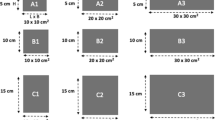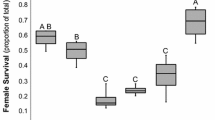Summary
Larval density of Culex fatigans essentially influences the predatory rate of the mosquito-fish Gambusia affinis. The feeding rate of the fish gradually increases up to a maximum value at intermediate prey densities beyond which there is an asymptotic saturation in the feeding rate. The relationship is represented by an empirical equation which helps in the prediction of the ideal stocking rate of the fish in natural systems.
Similar content being viewed by others
References
J. B. Gerberich and M. Laird, WHO/MAL/66-562, 1966.
C. S. Holling, Mem. ent. Soc. Can.48, 1 (1966).
D. W. Ware, J. Fish. Res. Bd. Can.29, 1193 (1972).
J. B. Hoy, G. Allen, O'Berg and Eugene E. Kauffman, Mosquito News31, No. 2 (1971).
J. T. Windell, in: The biological basis of freshwater fish production, p. 151. Blackwell Scientific publications. Oxford-Edinburgh 1967.
S. Katre, Cey. J. Sci. biol. Sci., in press (1977).
S. Mathavan, Hydrobiologia31, 55 (1976).
Author information
Authors and Affiliations
Rights and permissions
About this article
Cite this article
Reddy, S.R. An empirical relationship between the prey density and predatory efficiency ofGambusia affinis. Experientia 33, 1321–1322 (1977). https://doi.org/10.1007/BF01920157
Published:
Issue Date:
DOI: https://doi.org/10.1007/BF01920157




